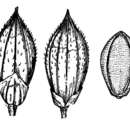Comprehensive Description
provided by North American Flora
Panicum adspersum Trin. Gram. Pan. 146. 1826
Panicum Thomasianum Steud.; Doell, in Mart. Fl. Bras. 2 2 : 188, as synonym. 1877.
Plants light-green, glabrous except as noted, ascending or spreading from a decumbent base, rooting at the lower nodes, commonly rather freely branching; culms 30-100 cm. high, compressed; leaf-sheaths shorter than the internodes, rather loose, densely ciliate at least toward the summit; Hgule a ciliate-membranaceous ring scarcely 1 mm. long; blades ascending or spreading, 5-15 cm., rarely as much as 20 cm. long, 8-20 mm. wide, abruptly acuminate, sometimes ciliate at the rounded base, scabrous on the margin; panicles rather short-exserted, 6-15 cm. long, composed of few to many ascending spike-like racemes 3-10 cm. long, the slender axes angled, scabrous, usually pubescent in the axils, bearing approximate, short-pediceled spikelets singly or two or three together on short branchlets along the under side; spikelets 3.2-4 mm. long, 1.5-1.8 mm. wide, fusiform, turgid, abruptly acuminate; first glume clasping, about one third the length of the spikelet, subacute, 5-nerved, glabrous ; second glume and sterile lemma exceeding the fruit and pointed beyond it, 5-7-nerved, hispid at least toward the summit, or sometimes hispidulous only, rarely glabrous, sometimes obscurely reticulate; fruit 2.2-3 mm. long, obovate, obtuse.
Typ© locality: Santo Domingo.
Distribution: Florida, Bahamas, and the West Indies.
- bibliographic citation
- George Valentine Nash. 1915. (POALES); POACEAE (pars). North American flora. vol 17(3). New York Botanical Garden, New York, NY
Physical Description
provided by USDA PLANTS text
Annuals, Terrestrial, not aquatic, Ste ms nodes swollen or brittle, Stems erect or ascending, Stems geniculate, decumbent, or lax, sometimes rooting at nodes, Stems caespitose, tufted, or clustered, Stems terete, round in cross section, or polygonal, Stem internodes hollow, Stems with inflorescence less than 1 m tall, Stems with inflorescence 1-2 m tall, Stems, culms, or scapes exceeding basal leaves, Leaves mostly cauline, Leaves conspicuously 2-ranked, distichous, Leaves sheathing at base, Leaf sheath mostly open, or loose, Leaf sheath smooth, glabrous, Leaf sheath and blade differentiated, Leaf blades linear, Leaf blades lanceolate, Leaf blades 2-10 mm wide, Leaf blades 1-2 cm wide, Leaf blades mostly flat, Leaf blades mostly glabrous, Leaf blades scabrous, roughened, or wrinkled, Ligule present, Ligule a fringe of hairs, Inflorescence terminal, Inflorescence solitary, with 1 spike, fascicle, glomerule, head, or cluster per stem or culm, Inflorescence a panicle with narrowly racemose or spicate branches, Infl orescence with 2-10 branches, Peduncle or rachis scabrous or pubescent, often with long hairs, Rachis angular, Flowers bisexual, Spikelets pedicellate, Spikelets sessile or subsessile, Spikelets dorsally compressed or terete, Spikelet less than 3 mm wide, Spikelets with 1 fertile floret, Spikelets with 2 florets, Spikelet with 1 fertile floret and 1-2 sterile florets, Spikelets paired at rachis nodes, Spikelets all alike and fertille, Spikelets bisexual, Spikelets disarticulating below the glumes, Spikelets secund, in rows on one side of rachis, Rachilla or pedicel glabrous, Glumes present, empty bracts, Glumes 2 clearly present, Glumes distinctly unequal, Glumes equal to or longer than adjacent lemma, Glume surface hairy, villous or pilose, Glumes 3 nerved, Lemma coriaceous, firmer or thicker in texture than the glumes, Lemma becoming indurate, enclosing palea and caryopsis, Lemma 5-7 nerved, Lemma glabrous, Lemma rugose, with cross wrinkles, or roughened, Lemma apex trunca te, rounded, or obtuse, Lemma awnless, Lemma margins inrolled, tightly covering palea and caryopsis, Lemma straight, Palea present, well developed, Palea longer than lemma, Stamens 3, Styles 2-fid, deeply 2-branched, Stigmas 2, Fruit - caryopsis.

